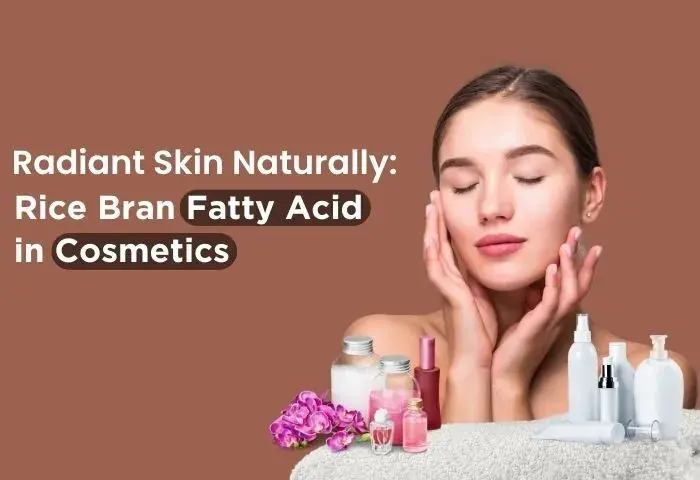In recent years, the world has witnessed a significant shift toward embracing natural and sustainable beauty products. As consumers become more conscious of what they put on their skin, the demand for plant-based ingredients in cosmetics has skyrocketed. Rice Bran Fatty Acid has become a powerful force in natural cosmetics among these prized botanical components.
Derived from the outer layer of rice grains, Rice Bran Fatty Acid garners attention for its exceptional skincare benefits. With the global beauty industry’s growing focus on harnessing the potency of nature’s offerings, it’s no wonder that this humble yet potent ingredient has found its place in the limelight.
We will shed light on the rise of natural cosmetics and the factors contributing to this significant shift in consumer preferences. Whether you are an avid skincare enthusiast, a beauty product connoisseur, or someone seeking natural alternatives for healthier skin, this blog aims to be your definitive guide on the importance and purpose of incorporating Rice Bran Fatty acids into your beauty routine.
Rice Bran Fatty Acid: An Overview
Rice bran is a byproduct of rice milling and is often considered waste. However, it is a rich source of valuable components, particularly rice bran fatty acids. These fatty acids have recently gained significant attention due to their impressive nutritional profile and beneficial properties for skin and hair
Extraction Process and Composition
The extraction of rice bran fatty acids involves a multi-step process that includes stabilising the rice bran to prevent rancidity, solvent extraction or mechanical pressing to separate the oil from the bran, and refining the oil to obtain the pure fatty acids.
Rice bran fatty acids are a diverse group of lipids, with their composition varying depending on factors such as rice variety, processing techniques, and geographical location. The primary fatty acids found in rice bran oil are oleic acid (monounsaturated), linoleic acid (polyunsaturated), and palmitic acid (saturated). It also contains smaller amounts of stearic acid, arachidonic acid, and several minor fatty acids.
Nutritional Profile
Rice bran fatty acids boast an impressive nutritional profile, making them valuable to a healthy diet. They are an excellent source of essential fatty acids, especially omega-6 fatty acids vital to maintaining healthy skin and hair. Moreover, rice bran fatty acids contain vitamin E, a potent antioxidant that helps protect cells from oxidative damage.
Antioxidant Properties
Rice bran fatty acid’s antioxidant properties are a significant factor in it’s popularity. These fatty acids contain various bioactive compounds, such as tocopherols, tocotrienols, and oryzanol, which exhibit potent antioxidant effects. Antioxidants help combat free radicals, unstable molecules contributing to premature ageing and skin damage. By neutralising free radicals, rice bran fatty acids promote healthier, more youthful-looking skin and strengthen hair from within.
Benefits for Skin
- Moisturization: Rice bran fatty acids are emollient and moisturizing, making them ideal for dry and sensitive skin. They create a protective barrier when applied topically, preventing moisture loss and keeping the skin supple.
- Skin Brightening: The presence of oryzanol in rice bran fatty acids can help reduce the appearance of dark spots and hyperpigmentation, resulting in a more even skin tone.
- Anti-Aging: The potent antioxidant activity of rice bran fatty acids aids in reducing the signs of ageing, such as fine lines and wrinkles. It helps maintain skin elasticity and firmness, leading to a youthful complexion.
Benefits for Hair
- Nourishment: When used in hair care products, rice bran fatty acids nourish the hair shaft, providing essential nutrients and promoting overall hair health.
- Frizz Control: The emollient properties of these fatty acids tame frizz and flyaways, leaving hair smooth and manageable.
- UV Protection: The antioxidant-rich composition of rice bran fatty acids provides a natural shield against harmful UV rays, protecting the hair from sun damage.
The Popularity of Natural Cosmetics
The rise in popularity of natural cosmetics can be attributed to several factors, but at its core, it stems from consumers’ desire for safer, healthier, and more sustainable beauty options.
With the increasing awareness of the potentially harmful effects of synthetic chemicals in conventional beauty products, consumers are actively seeking alternatives that offer more natural and gentle solutions for their skincare and makeup needs.
Key Benefits of Using Natural Cosmetics
- Gentle on the Skin: Natural cosmetics are formulated with organic and plant-based ingredients, free from harsh chemicals that can cause irritation or allergies. They work harmoniously with the skin, providing nourishment and protection without harmful side effects.
- Cruelty-Free and Ethical Practices: Many natural cosmetic brands are committed to cruelty-free practices, meaning they don’t test their products on animals. Ethical brands also ensure fair treatment of workers and engage in responsible sourcing practices.
- Reduced Environmental Impact: Unlike conventional beauty products that often come in non-recyclable or excessive packaging, natural cosmetic brands focus on eco-friendly packaging solutions, reducing plastic waste and minimising carbon footprint.
Role of Rice Bran Fatty Acid in Natural Cosmetics
Emollient and Moisturizing Properties
Rice bran fatty acid boasts exceptional emollient properties, forming a protective barrier on the skin’s surface, sealing in moisture, and preventing dehydration. As a result, natural cosmetics infused with rice bran fatty acid can effectively combat dryness, leaving the skin feeling supple and revitalised.
Skin Barrier Enhancement
Maintaining a robust skin barrier is crucial for overall skin health, and rice bran fatty acid is pivotal in enhancing this protective layer. Combining ceramides, sterols, and squalene in rice bran fatty acid helps fortify the skin barrier, preventing moisture loss and safeguarding the skin from external aggressors. This added protection can aid in addressing various skin conditions like eczema and dermatitis.
Skin Soothing and Anti-Inflammatory Effects
For individuals with sensitive or inflamed skin, the anti-inflammatory properties of rice bran fatty acid can offer much-needed relief. When applied topically, it helps soothe irritation, redness, and itching, making it an excellent choice for calming reactive skin. Its gentle nature also makes it suitable for sensitive skin types, providing nourishment without causing further irritation.
Rice Bran Fatty Acid in Skincare Products
Face Serums and Creams
Face serums and creams are crucial in our daily skincare routine, and incorporating RBFA into these products can elevate their effectiveness. The high concentration of antioxidants in RBFA helps combat free radicals, reducing signs of ageing and promoting a youthful complexion. When applied as part of a serum, it can penetrate deep into the skin, boosting collagen production and improving skin elasticity.
RBFA-infused creams provide:
- Long-lasting hydration.
- Soothing dry and sensitive skin.
- Even helping to diminish the appearance of dark spots and blemishes.
Body Lotions
Our body’s skin needs nourishment and protection, and RBFA-infused body lotions and balms can work wonders. The lightweight and non-greasy nature of RBFA makes it an ideal ingredient for body lotions that effectively moisturise the skin without leaving any residue.
Lip Balms and Hydrating Masks
The delicate skin of our lips deserves special care, and lip balms enriched with RBFA can provide just that. RBFA forms a protective barrier on the lips, shielding them from harsh environmental factors and preventing moisture loss. It also helps repair chapped lips, leaving them soft and supple.
Shampoos and Conditioners
RBFA is not only beneficial for the skin but also for our hair. Shampoos infused with RBFA can effectively cleanse the scalp while retaining natural oils, promoting a healthy scalp environment. The essential fatty acid helps nourish the hair follicles, preventing breakage and promoting hair growth. Paired with RBFA-enriched conditioners, it helps restore moisture, improve hair texture, and leave the hair looking shiny and lustrous.
Hair Masks and Leave-in Treatments
For those seeking an extra boost of hair care, RBFA-infused hair masks and leave-in treatments are the way to go. These intensive treatments penetrate deep into the hair shaft, repairing damaged hair and reducing frizz. The nutrient-rich RBFA helps strengthen the hair strands, making them more resilient to external stressors. Leave-in treatments provide continuous nourishment, making hair manageable and noticeably smoother.
Parting Thoughts
We have delved into natural cosmetics and explored the incredible benefits of incorporating Rice Bran Fatty Acid into these products. As we recap, it’s evident that Rice Bran Fatty Acid offers many advantages for both consumers and the environment.
Choosing SVR Oil’s natural cosmetics with ingredients like Rice Bran Fatty Acid nurtures our skin and contributes to a healthier planet. By opting for products that use renewable and ethically sourced ingredients, we actively participate in reducing our ecological footprint and preserving the Earth’s resources for future generations.
Let us embrace the remarkable potential of Rice Bran Fatty Acid in natural cosmetics and take a step towards a more sustainable and eco-friendly future. By making conscious choices and supporting ethical brands, we can play an active role in shaping a healthier and greener world for ourselves and future generations.
Contact us today to learn more about Rice bran fatty acids.

